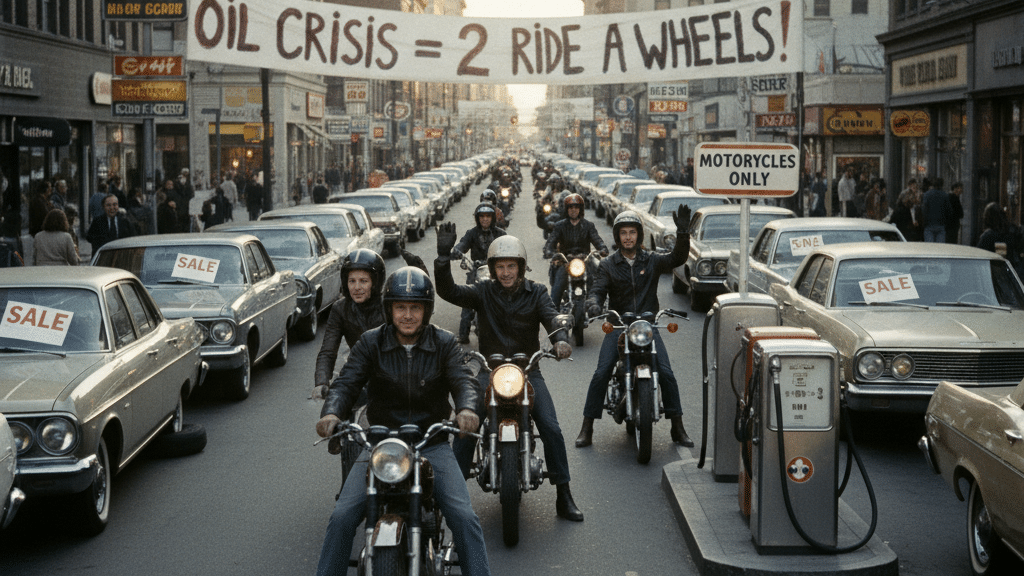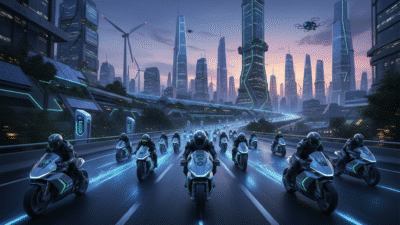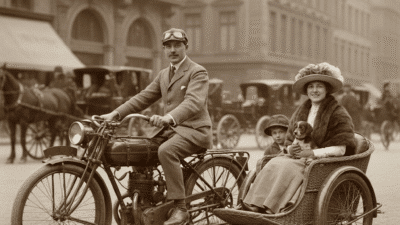The rumble of an engine, the open road stretching ahead, the wind in your face – these are the classic images associated with motorcycling. But beneath the thrill and freedom lies a fascinating economic story, one where global turmoil unwittingly fueled a revolution on two wheels. We’re diving deep into the captivating narrative of The oil crisis and its effect on motorcycle popularity, exploring how periods of soaring fuel prices didn’t just drain wallets, but also sparked an unexpected surge in demand for these agile machines. Get ready to rev up your understanding, because the connection between economic hardship and the motorcycle’s rise is more profound and thrilling than you might imagine! This isn’t just about saving a buck at the pump; it’s about shifting mindsets, adapting to new realities, and rediscovering the sheer joy and practicality of two-wheeled transport.
The Tremors of Crisis: When Fuel Became a Luxury
Imagine a world where the very lifeblood of modern society – oil – suddenly became a scarce and prohibitively expensive commodity. This wasn’t a hypothetical scenario; it was a harsh reality that hit the globe multiple times, most notably in the 1970s. The 1973 oil embargo, triggered by geopolitical events, sent shockwaves through economies worldwide. Gasoline prices skyrocketed, lines at gas stations stretched for miles, and a sense of panic set in. Suddenly, the gas-guzzling American dream machine became an albatross around many necks.
Decades later, similar, albeit less severe, spikes occurred. The early 2000s saw another surge in oil prices, driven by increased global demand and instability in oil-producing regions. Each time, the impact was immediate and widespread. Industries reliant on cheap fuel faced immense pressure, and ordinary consumers felt the squeeze every time they filled their tanks. For many, the daily commute, once a mundane routine, transformed into a costly burden. Public transportation, while a viable alternative for some, wasn’t always practical or accessible for everyone. People needed solutions, and they needed them fast. They looked for ways to cut costs without sacrificing their mobility entirely. This urgent need for economical transport created a fertile ground for an unexpected hero to emerge: the motorcycle.

The Motorcycle’s Moment: A Beacon of Efficiency
When fuel efficiency became the holy grail, motorcycles shone brightly. Compared to the average car, even small-displacement motorcycles offered vastly superior mileage. A car getting 20 miles per gallon (MPG) seemed extravagant when a motorcycle could easily achieve 50, 60, or even 70+ MPG. This stark difference was a game-changer for budget-conscious commuters. The immediate savings at the pump were undeniable, making the initial investment in a motorcycle a far more appealing proposition.
Beyond just fuel, the economics of motorcycling extended to other areas. Motorcycles typically have lower purchase prices than cars, especially entry-level models. Insurance costs can often be more affordable, and general maintenance expenses are usually less demanding, provided proper care is taken. Consider the ease of finding parking, often free or significantly cheaper than car parking in congested urban centers. These seemingly minor cost differences accumulated, presenting a compelling financial argument for switching to two wheels. It wasn’t just about surviving the crisis; it was about thriving within new economic constraints.
The Rise of Commuter Bikes
This shift wasn’t lost on manufacturers. They quickly adapted, moving away from solely performance-focused or cruiser models to embrace the burgeoning market for commuter-friendly motorcycles. Smaller engines, upright riding positions, and practical features became priorities. Suddenly, bikes like Honda’s CB series, Kawasaki’s KZ models, and various Suzuki and Yamaha offerings found renewed purpose, catering directly to the needs of the everyday rider. These weren’t flashy machines designed for weekend thrills; they were reliable, efficient workhorses built to navigate the new economic landscape. The market responded enthusiastically, validating the manufacturers’ foresight and cementing the motorcycle’s role as a practical mode of transport.
Pros and Cons
| Pros | Cons |
|---|---|
| – Superior fuel efficiency saves money. | – Increased vulnerability on the road. |
| – Lower purchase and maintenance costs. | – Weather dependency can limit use. |
| – Easier maneuverability and parking in urban areas. | – Limited passenger and cargo capacity. |
| – Sense of freedom and connection to the road. | – Steeper learning curve for new riders. |
| – Reduced traffic congestion. | – Potential for higher insurance in some cases. |
More Than Just Economy: The Freedom and Practicality Factor
While economics undoubtedly played a pivotal role, the surge in motorcycle popularity during oil crises wasn’t just about saving money. It tapped into a deeper desire for freedom, efficiency, and a more engaging way to navigate the world. For many, a motorcycle offered an escape from the mundane, even amidst economic uncertainty. The sheer joy of riding, the connection to the road, and the ability to weave through congested traffic were powerful motivators.
Imagine the frustration of sitting in endless traffic jams, knowing that every minute wasted is also fuel wasted. Motorcycles offered a tangible solution. Their nimble size allows riders to navigate tight spaces, bypass gridlock (where legal and safe), and drastically cut down commute times. This time-saving aspect, particularly in sprawling urban environments, became an invaluable benefit. Furthermore, the psychological impact of being able to control your journey, rather than being confined within a metal box, offered a profound sense of empowerment. It wasn’t just a vehicle; it was a tool for reclaiming personal agency in a world that felt increasingly out of control.

Urban Mobility Redefined
Cities, in particular, saw a noticeable shift. Parking, a perennial headache for car owners, became far less of an issue for motorcyclists. Spaces that were too small for cars were perfect for bikes. This urban advantage contributed significantly to the growing appeal, especially in densely populated areas where every square foot of road and parking space is precious. The motorcycle transitioned from a niche hobbyist’s vehicle to a legitimate, often superior, option for daily urban transit. This practical advantage, combined with the economic benefits, solidified its position as a serious contender for personal mobility.
Innovation Under Pressure: Motorcycle Evolution Through Crises
Necessity is the mother of invention, and the oil crises certainly spurred innovation within the motorcycle industry. Manufacturers weren’t content to simply offer more fuel-efficient versions of existing models. They began to rethink motorcycle design from the ground up, focusing on usability, reliability, and broad appeal. This period saw a significant push towards more user-friendly machines, often incorporating technologies that enhanced both performance and economy.
For instance, the development of more precise carburetion systems and later, sophisticated fuel injection, played a crucial role in optimizing fuel delivery and combustion, making bikes even more efficient. If you’re curious about how these modern systems work and how to keep them running smoothly, you might find this article on how to maintain a fuel-injected motorcycle incredibly useful. This era also witnessed an evolution in engine design, aiming for lighter, more compact power plants that delivered adequate power without excessive fuel consumption. The industry learned valuable lessons about balancing performance with practicality, a balance that continues to influence motorcycle design today. To understand how these designs came to be, exploring the evolution of early motorcycle engines provides fascinating historical context.

A Global Phenomenon
This trend wasn’t confined to one region. In Europe, already accustomed to smaller vehicles and higher fuel taxes, the motorcycle’s appeal only intensified. Asian manufacturers, already masters of efficient, small-displacement engines, saw their market share expand globally. Brands like Honda, Yamaha, Suzuki, and Kawasaki capitalized on the demand for reliable, affordable, and fuel-sipping bikes. Their models became synonymous with sensible transportation, offering a stark contrast to the larger, less efficient vehicles that dominated the roads before the crises hit. The global automotive landscape was undeniably shifting, and motorcycles were at the forefront of this change.
Beyond the Immediate Crisis: An Enduring Legacy
While the immediate spikes in motorcycle sales often correlated with specific oil price surges, the impact of these crises extended far beyond the short term. They fundamentally altered public perception of motorcycles. What was once seen as a rebellious symbol or a weekend toy began to be recognized as a legitimate, highly practical form of transportation. This shift in perception opened the door for a wider demographic of riders, including daily commuters, urban dwellers, and even families looking for a second, more economical vehicle.
The habit of riding, once formed out of necessity, often stuck. People discovered the inherent advantages of motorcycling – the ease of movement, the lower operating costs, and the undeniable sense of engagement with the road. Many who bought bikes purely for economic reasons found themselves falling in love with the riding experience itself. This laid the groundwork for a sustained interest in motorcycling, even during periods of more stable fuel prices. The crises acted as a catalyst, introducing millions to a mode of transport they might never have considered otherwise. This expansion of the riding community had a lasting effect on motorcycle culture and industry.

Modern Echoes and Future Horizons
Today, we continue to see the influence of these past crises. Concerns about environmental impact, urban congestion, and rising living costs keep the motorcycle’s appeal alive and well. Electric motorcycles, offering zero emissions and significantly lower running costs, represent the next evolution in this narrative, continuing the legacy of efficient, economical two-wheeled transport. The fundamental desire for personal mobility that is both practical and exhilarating remains a powerful force.
For anyone who relies on a motorcycle, whether it’s a classic gas-powered machine or a sleek electric model, proper care is paramount. Regular check-ups and maintenance are key to ensuring longevity and efficiency. Understanding the importance of regular maintenance intervals for your motorcycle can save you money and keep you safely on the road.
The Essential Art of Motorcycle Maintenance
Embracing the motorcycle lifestyle, especially for its economic benefits, comes with a responsibility: proper maintenance. A well-maintained motorcycle is not only safer and more reliable, but it also retains its fuel efficiency and extends its lifespan, truly maximizing those cost savings. Just like any other vehicle, a motorcycle needs regular attention to ensure all its components are functioning optimally.
Think about the critical parts: the engine, the chain, the tires, the brakes, and the electrical system. Each requires specific care. For instance, knowing how to check and change motorcycle oil is fundamental. The oil is the lifeblood of your engine, ensuring smooth operation and preventing premature wear. Similarly, keeping your chain properly cleaned and lubricated is vital for efficient power transfer and extending the life of your drivetrain. Neglecting these seemingly small tasks can lead to bigger, more expensive problems down the line, negating the very economic advantages that attracted many riders in the first place.
Beyond the engine and drivetrain, elements like your tires, brakes, and suspension contribute significantly to both safety and performance. Regularly inspecting your tires for wear and proper inflation, checking your brake pads, and ensuring your suspension components are in good order are non-negotiable aspects of responsible motorcycle ownership. These aren’t just technicalities; they’re investments in your safety and the longevity of your ride. Embracing a proactive maintenance mindset ensures that your motorcycle remains the efficient, reliable, and enjoyable mode of transport it was designed to be, continuing to deliver value long after the initial crisis has passed.

Revving Forward: The Motorcycle’s Undeniable Place
The story of the oil crisis and its effect on motorcycle popularity is a powerful testament to human adaptability and the enduring appeal of the motorcycle. What began as a reluctant economic choice for many quickly blossomed into a genuine appreciation for the unique benefits these machines offer. From the immediate relief at the gas pump to the exhilarating sense of freedom on the open road, motorcycles provided a practical, engaging, and often joyful solution to periods of economic uncertainty. They reshaped commutes, influenced urban planning, and left an indelible mark on global transportation culture.
Today, as we face new challenges – from climate change to increasingly congested cities – the lessons learned from past oil crises remain incredibly relevant. Motorcycles, particularly with the advent of electric models, continue to offer a compelling vision for efficient, sustainable, and enjoyable personal mobility. The next time you see a motorcycle zip past, remember its history. It’s not just a machine; it’s a symbol of resilience, innovation, and the enduring human spirit to keep moving forward, no matter what hurdles lie in the road ahead. Embrace the ride, understand its roots, and maybe, just maybe, you’ll find yourself wondering if it’s time to join the two-wheeled revolution!

Frequently Asked Questions
What major oil crises impacted motorcycle popularity?
The most significant was the 1973 oil embargo, which caused gasoline prices to skyrocket and led to long lines at gas stations. Later spikes in the early 2000s also contributed to increased interest in fuel-efficient vehicles, including motorcycles.
Why did motorcycles become more popular during oil crises?
Motorcycles offered significantly better fuel economy compared to cars, making them a much more economical choice when gasoline prices were high. They also had lower purchase prices, cheaper insurance, and easier parking, further enhancing their appeal.
How did motorcycle manufacturers respond to the increased demand?
Manufacturers adapted by focusing on developing and promoting more commuter-friendly models. They prioritized smaller, more fuel-efficient engines, upright riding positions, and practical features over purely performance-driven designs. Innovations like fuel injection also helped optimize efficiency.
Were the reasons for increased motorcycle popularity purely economic?
While economic factors were a primary driver, the appeal went beyond just saving money. Riders also valued the sense of freedom, the ability to bypass traffic congestion, and the ease of parking in urban environments, all of which contributed to a more engaging and efficient commute.
Did this popularity surge last beyond the immediate crisis periods?
Yes, the crises fundamentally changed public perception, introducing a wider demographic to the practical benefits of motorcycling. Many riders who initially bought bikes for economic reasons discovered the joy of riding, leading to a sustained interest and a lasting impact on motorcycle culture and industry.
What role do motorcycles play in modern transportation challenges?
Motorcycles continue to be relevant for addressing contemporary challenges like urban congestion, rising fuel costs, and environmental concerns. The emergence of electric motorcycles further solidifies their position as a sustainable and efficient solution for personal mobility in the future.
What is the importance of maintenance for motorcycles, especially for fuel efficiency?
Proper and regular maintenance is crucial for a motorcycle’s longevity, safety, and continued fuel efficiency. Tasks like checking and changing oil, cleaning and lubricating the chain, and inspecting tires and brakes ensure the motorcycle operates optimally, maximizing its economic benefits and preventing costly repairs.



